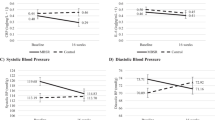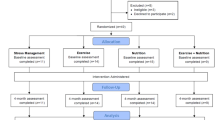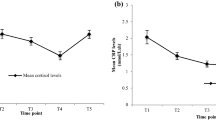Abstract
Purpose
Older cancer survivors are a vulnerable population due to an increased risk for chronic diseases (e.g., cardiovascular disease) compounded with treatment late-effects and declines in physical functioning. Therefore, interventions that reduce chronic disease risk factors (i.e., blood pressure, chronic inflammation, and cortisol) are important in this population. Tai chi chih (TCC) is a mind-body exercise associated with reductions in chronic disease risk factors, but has not been examined with older cancer survivors. In a feasibility randomized controlled trial of TCC, we examined secondary outcomes of blood pressure, salivary cortisol, and inflammatory cytokines (interleukin (IL)-6, IL-12, tumor necrosis factor-α, IL-10, IL-4) due to their implications in chronic diseases.
Methods
Sixty-three senior female cancer survivors (M age = 67 years, SD = 7.15) with physical functioning limitations (SF-12 physical functioning ≤80 or role-physical ≤72) were randomized to 12-weeks (60-min, three times a week) of TCC or Health Education control (HEC) classes. Resting blood pressure, 1-day salivary cortisol samples, and fasting plasma samples for cytokine multiplex assays were collected at baseline and 1-week post-intervention.
Results
Controlling for baseline values, the TCC group had significantly lower systolic blood pressure (SBP, p = 0.002) and cortisol area-under-curve (AUC, p = 0.02) at post-intervention than the HEC group. There was no intervention effect on inflammatory cytokines (p’s > 0.05).
Conclusions
This TCC feasibility trial was associated with significant reductions in SBP and cortisol AUC in senior female cancer survivors. Larger, definitive trials are needed to confirm these findings.
Implications for Cancer Survivors
Senior survivors’ have an increased risk for chronic diseases; however, TCC interventions may help reduce associated risk factors.


Similar content being viewed by others
Notes
The study’s physical assessments (i.e., blood draw for cytokines, blood pressure assessed) were held during a morning session 1 week before the classes began, before participants’ randomization to study group, and during a morning session 1 week following the last study class. The sessions were held in a group format in which all the participants attended.
We also conducted an ANCOVA subanalysis for SBP that excluded the five TCC participants who reported a history of a heart attack and found similar results (p = 0.004).
The sample times for the cortisol AUC analysis were fixed at 7:00 am, 7:30 am, 12:00 noon, 5:00 pm, and 10:00 pm. We recognize that this is a study limitation and that these results should be viewed as preliminary.
References
Parry C, Kent EE, Mariotto AB, Alfano CM, Rowland JH. Cancer survivors: a booming population. Cancer Epidemiol Biomarkers Prev. 2011;20(10):1996–2005. doi:10.1158/1055-9965.EPI-11-0729.
ACS. Cancer treatment and survivorship facts & Figs. 2012–2013. Atlanta: American Cancer Society; 2012.
Byers T, Patnaik JL. Missed opportunities for chronic disease prevention after breast cancer. Womens Health (London England). 2011;7(6):619–21. doi:10.2217/whe.11.66.
Demark-Wahnefried W, Pinto BM, Gritz ER. Promoting health and physical function among cancer survivors: potential for prevention and questions that remain. J Clin Oncol. 2006;24(32):5125–31.
Rao AV, Demark-Wahnefried W. The older cancer survivor. Crit Rev Oncol Hematol. 2006;60(2):131–43.
Rowland JH, Yancik R. Cancer survivorship: the interface of aging, comorbidity, and quality care. J Natl Cancer Inst. 2006;98(8):504–5.
Hewitt M, Rowland JH, Yancik R. Cancer survivors in the United States: age, health, and disability. J Gerontol A Biol Sci Med Sci. 2003;58(1):82–91.
Yancik R, Ganz PA, Varricchio CG, Conley B. Perspectives on comorbidity and cancer in older patients: approaches to expand the knowledge base. J Clin Oncol. 2001;19(4):1147–51.
Patnaik JL, Byers T, Diguiseppi C, Denberg TD, Dabelea D. The influence of comorbidities on overall survival among older women diagnosed with breast cancer. J Natl Cancer Inst. 2011;103(14):1101–11. doi:10.1093/jnci/djr188.
Patnaik JL, Byers T, DiGuiseppi C, Dabelea D, Denberg TD. Cardiovascular disease competes with breast cancer as the leading cause of death for older females diagnosed with breast cancer: a retrospective cohort study. Breast Cancer Res. 2011;13(3):R64. doi:10.1186/bcr2901.
Yusuf SW, Sami S, Daher IN. Radiation-induced heart disease: a clinical update. Cardiol Res Pract. 2011;2011:317659. doi:10.4061/2011/317659.
Weaver KE, Foraker RE, Alfano CM, Rowland JH, Arora NK, Bellizzi KM, et al. Cardiovascular risk factors among long-term survivors of breast, prostate, colorectal, and gynecologic cancers: a gap in survivorship care? J Cancer Surviv. 2013;7(2):253–61. doi:10.1007/s11764-013-0267-9.
Haque R, Prout M, Geiger AM, Kamineni A, Thwin SS, Avila C, et al. Comorbidities and cardiovascular disease risk in older breast cancer survivors. Am J Manag Care. 2014;20(1):86–92.
Keating NL, Norredam M, Landrum MB, Huskamp HA, Meara E. Physical and mental health status of older long-term cancer survivors. J Am Geriatr Soc. 2005;53(12):2145–52.
Warburton DE, Nicol CW, Bredin SS. Health benefits of physical activity: the evidence. CMAJ. 2006;174(6):801–9. doi:10.1503/cmaj.051351.
Holmes MD, Chen WY, Feskanich D, Kroenke CH, Colditz GA. Physical activity and survival after breast cancer diagnosis. JAMA. 2005;293(20):2479–86.
Irwin ML, Smith AW, McTiernan A, Ballard-Barbash R, Cronin K, Gilliland FD, et al. Influence of pre- and postdiagnosis physical activity on mortality in breast cancer survivors: the health, eating, activity, and lifestyle study. J Clin Oncol. 2008;26(24):3958–64. doi:10.1200/JCO.2007.15.9822.
Courneya KS, Vallance JK, McNeely ML, Karvinen KH, Peddle CJ, Mackey JR. Exercise issues in older cancer survivors. Crit Rev Oncol Hematol. 2004;51(3):249–61. doi:10.1016/j.critrevonc.2004.05.001.
Irwin ML, McTiernan A, Bernstein L, Gilliland FD, Baumgartner R, Baumgartner K, et al. Physical activity levels among breast cancer survivors. Med Sci Sports Exerc. 2004;36(9):1484–91.
Larkey L, Jahnke R, Etnier J, Gonzalez J. Meditative movement as a category of exercise: implications for research. J Phys Act Health. 2009;6(2):230–8.
Rogers CE, Larkey LK, Keller C. A review of clinical trials of tai chi and qigong in older adults. West J Nurs Res. 2009;31(2):245–79. doi:10.1177/0193945908327529.
Hui SS, Woo J, Kwok T. Evaluation of energy expenditure and cardiovascular health effects from tai chi and walking exercise. Hong Kong Med J Xianggang Hong Kong Acad Med. 2009;15 Suppl 2:4–7.
Fontana JA, Colella C, Wilson BR, Baas L. The energy costs of a modified form of tai chi exercise. Nurs Res. 2000;49(2):91–6. doi:10.1097/00006199-200003000-00005.
Jahnke R, Larkey L, Rogers C, Etnier J, Lin F. A comprehensive review of health benefits of qigong and tai chi. Am J Health Promot: AJHP. 2010;24(6):e1–e25. doi:10.4278/ajhp.081013-LIT-248.
Motivala SJ, Sollers J, Thayer J, Irwin MR. Tai chi chih acutely decreases sympathetic nervous system activity in older adults. J Gerontol A Biol Sci Med Sci. 2006;61(11):1177–80.
Yeh GY, Wang C, Wayne PM, Phillips RS. The effect of tai chi exercise on blood pressure: a systematic review. Prev Cardiol. 2008;11(2):82–9.
Lan C, Chen SY, Wong MK, Lai JS. Tai chi chuan exercise for patients with cardiovascular disease. Evid Based Complement Alternat Med. 2013;2013:983208. doi:10.1155/2013/983208.
Janelsins MC, Davis PG, Wideman L, Katula JA, Sprod LK, Peppone LJ, et al. Effects of tai chi chuan on insulin and cytokine levels in a randomized controlled pilot study on breast cancer survivors. Clin Breast Cancer. 2011;11(3):161–70. doi:10.1016/j.clbc.2011.03.013.
Lavretsky H, Alstein LL, Olmstead RE, Ercoli LM, Riparetti-Brown M, Cyr NS, et al. Complementary use of Tai Chi chih augments escitalopram treatment of geriatric depression: a randomized controlled trial. Am J Geriatr Psychiatr. 2011;19(10):839–50. doi:10.1097/JGP.0b013e31820ee9ef.
Irwin MR, Olmstead R. Mitigating cellular inflammation in older adults: a randomized controlled trial of tai chi chih. Am J Geriatr Psychiatry. 2012;20(9):764–72. doi:10.1097/JGP.0b013e3182330fd3.
Irwin MR, Olmstead R, Oxman MN. Augmenting immune responses to varicella zoster virus in older adults: a randomized, controlled trial of tai chi. J Am Geriatr Soc. 2007;55(4):511–7.
Irwin MR, Pike JL, Cole JC, Oxman MN. Effects of a behavioral intervention, tai chi chih, on varicella-zoster virus specific immunity and health functioning in older adults. Psychosom Med. 2003;65(5):824–30.
Mustian KM, Palesh OG, Flecksteiner SA. Tai chi chuan for breast cancer survivors. Med Sport Sci. 2008;52:209–17. doi:10.1159/000134301.
Mustian KM, Katula JA, Zhao H. A pilot study to assess the influence of tai chi chuan on functional capacity among breast cancer survivors. J Support Oncol. 2006;4(3):139–45.
Peppone LJ, Mustian KM, Janelsins MC, Palesh OG, Rosier RN, Piazza KM, et al. Effects of a structured weight-bearing exercise program on bone metabolism among breast cancer survivors: a feasibility trial. Clin Breast Cancer. 2010;10(3):224–9. doi:10.3816/CBC.2010.n.030.
Sprod LK, Janelsins MC, Palesh OG, Carroll JK, Heckler CE, Peppone LJ, et al. Health-related quality of life and biomarkers in breast cancer survivors participating in tai chi chuan. J Cancer Surviv. 2012;6(2):146–54. doi:10.1007/s11764-011-0205-7.
Mustian KM, Katula JA, Gill DL, Roscoe JA, Lang D, Murphy K. Tai chi chuan, health-related quality of life and self-esteem: a randomized trial with breast cancer survivors. Support Care Cancer. 2004;12(12):871–6. doi:10.1007/s00520-004-0682-6.
Irwin M, Pike J, Oxman M. Shingles immunity and health functioning in the elderly: Tai Chi chih as a behavioral treatment. Evid Based Complement Alternat Med. 2004;1(3):223–32.
Lutgendorf SK, Costanzo ES. Psychoneuroimmunology and health psychology: an integrative model. Brain Behav Immun. 2003;17(4):225–32.
Friedman EM, Irwin MR. Modulation of immune cell function by the autonomic nervous system. Pharmacol Ther. 1997;74(1):27–38.
Elenkov IJ. Glucocorticoids and the Th1/Th2 balance. Ann N Y Acad Sci. 2004;1024:138–46. doi:10.1196/annals.1321.010.
Cohen S, Janicki-Deverts D, Doyle WJ, Miller GE, Frank E, Rabin BS, et al. Chronic stress, glucocorticoid receptor resistance, inflammation, and disease risk. Proc Natl Acad Sci U S A. 2012;109(16):5995–9. doi:10.1073/pnas.1118355109.
Licastro F, Candore G, Lio D, Porcellini E, Colonna-Romano G, Franceschi C, et al. Innate immunity and inflammation in ageing: a key for understanding age-related diseases. Immun Ageing I A. 2005;2:8. doi:10.1186/1742-4933-2-8.
Aw D, Silva AB, Palmer DB. Immunosenescence: emerging challenges for an ageing population. Immunology. 2007;120(4):435–46. doi:10.1111/j.1365-2567.2007.02555.x.
Pearson TA, Mensah GA, Alexander RW, Anderson JL, Cannon 3rd RO, Criqui M, et al. Markers of inflammation and cardiovascular disease: application to clinical and public health practice: a statement for healthcare professionals from the Centers for Disease Control and Prevention and the American Heart Association. Circulation. 2003;107(3):499–511.
Coussens LM, Werb Z. Inflammation and cancer. Nature. 2002;420(6917):860–7. doi:10.1038/nature01322.
Cesari M, Penninx BW, Pahor M, Lauretani F, Corsi AM, Rhys Williams G, et al. Inflammatory markers and physical performance in older persons: the InCHIANTI study. J Gerontol A Biol Sci Med Sci. 2004;59(3):242–8.
Krabbe KS, Pedersen M, Bruunsgaard H. Inflammatory mediators in the elderly. Exp Gerontol. 2004;39(5):687–99. doi:10.1016/j.exger.2004.01.009.
Daher IN, Daigle TR, Bhatia N, Durand JB. The prevention of cardiovascular disease in cancer survivors. Tex Heart Inst J, St Luke’s Episcopal Hosp, Tex Child Hosp. 2012;39(2):190–8.
He J, Whelton PK. Elevated systolic blood pressure and risk of cardiovascular and renal disease: overview of evidence from observational epidemiologic studies and randomized controlled trials. Am Heart J. 1999;138(3 Pt 2):211–9.
Egan BM, Zhao Y, Axon RN. US trends in prevalence, awareness, treatment, and control of hypertension, 1988–2008. JAMA. 2010;303(20):2043–50. doi:10.1001/jama.2010.650.
Lutgendorf SK, Sood AK. Biobehavioral factors and cancer progression: physiological pathways and mechanisms. Psychosom Med. 2011;73(9):724–30. doi:10.1097/PSY.0b013e318235be76.
Elenkov IJ, Chrousos GP. Stress hormones, proinflammatory and antiinflammatory cytokines, and autoimmunity. Ann N Y Acad Sci. 2002;966:290–303.
Campo RA, O’Connor K, Light KC, Nakamura Y, Lipschitz DL, LaStayo PC, et al. Feasibility and acceptability of a tai chi chih randomized controlled trial in senior female cancer survivors. Integr Cancer Ther. 2013;12(6):464–74. doi:10.1177/1534735413485418.
Schulz KF, Altman DG, Moher D. CONSORT 2010 statement: updated guidelines for reporting parallel group randomised trials. Int J Surg. 2011;9(8):672–7. doi:10.1016/j.ijsu.2011.09.004.
Martins TB, Pasi BM, Pickering JW, Jaskowski TD, Litwin CM, Hill HR. Determination of cytokine responses using a multiplexed fluorescent microsphere immunoassay. Am J Clin Pathol. 2002;118(3):346–53. doi:10.1309/N0T6-C56B-GXB2-NVFB.
Hill HR, Martins TB. The flow cytometric analysis of cytokines using multi-analyte fluorescence microarray technology. Methods. 2006;38(4):312–6. doi:10.1016/j.ymeth.2005.11.014.
Zeng Y, Luo T, Xie H, Huang M, Cheng AS. Health benefits of qigong or tai chi for cancer patients: a systematic review and meta-analyses. Complement Ther Med. 2014;22(1):173–86. doi:10.1016/j.ctim.2013.11.010.
Schutzer KA, Graves BS. Barriers and motivations to exercise in older adults. Prev Med. 2004;39(5):1056–61. doi:10.1016/j.ypmed.2004.04.003.
Galvao DA, Newton RU. Review of exercise intervention studies in cancer patients. J Clin Oncol. 2005;23(4):899–909. doi:10.1200/JCO.2005.06.085.
Kunz-Ebrecht SR, Kirschbaum C, Marmot M, Steptoe A. Differences in cortisol awakening response on work days and weekends in women and men from the Whitehall II cohort. Psychoneuroendocrinology. 2004;29(4):516–28.
Aardal E, Holm AC. Cortisol in saliva—reference ranges and relation to cortisol in serum. Eur J Clin Chem Clin Biochem: J Forum Eur Clin Chem Soc. 1995;33(12):927–32.
Yeh GY, Wang C, Wayne PM, Phillips R. Tai chi exercise for patients with cardiovascular conditions and risk factors: a systematic review. J Cardiopulm Rehabil Prev. 2009;29(3):152–60. doi:10.1097/HCR.0b013e3181a33379.
Chen Z, Meng Z, Milbury K, Bei W, Zhang Y, Thornton B, et al. Qigong improves quality of life in women undergoing radiotherapy for breast cancer: results of a randomized controlled trial. Cancer. 2013. doi:10.1002/cncr.27904.
Lutgendorf SK, Weinrib AZ, Penedo F, Russell D, DeGeest K, Costanzo ES, et al. Interleukin-6, cortisol, and depressive symptoms in ovarian cancer patients. J Clin Oncol. 2008;26(29):4820–7. doi:10.1200/JCO.2007.14.1978.
Sephton SE, Sapolsky RM, Kraemer HC, Spiegel D. Diurnal cortisol rhythm as a predictor of breast cancer survival. J Natl Cancer Inst. 2000;92(12):994–1000.
Woods JA, Wilund KR, Martin SA, Kistler BM. Exercise, inflammation and aging. Aging Dis. 2012;3(1):130–40.
Oh B, Butow PN, Mullan BA, Clarke SJ, Beale PJ, Pavlakis N, et al. Effect of medical Qigong on cognitive function, quality of life, and a biomarker of inflammation in cancer patients: a randomized controlled trial. Support Care Cancer. 2011. doi:10.1007/s00520-011-1209-6.
Christian LM, Deichert NT, Gouin J-P, Graham JE, Kiecolt-Glaser JK. Psychological influences on neuroendocrine and immune outcomes. In: Berntson JTCGG, editor. Handbook of neuroscience for the behavioral sciences. Hoboken: Wiley; 2009. p. 1260–79.
Carlson LE, Speca M, Faris P, Patel KD. One year pre-post intervention follow-up of psychological, immune, endocrine and blood pressure outcomes of mindfulness-based stress reduction (MBSR) in breast and prostate cancer outpatients. Brain Behav Immun. 2007;21(8):1038–49. doi:10.1016/j.bbi.2007.04.002.
Keating NL, O’Malley AJ, Smith MR. Diabetes and cardiovascular disease during androgen deprivation therapy for prostate cancer. J Clin Oncol. 2006;24(27):4448–56.
Kirschbaum C, Hellhammer DH. Salivary cortisol in psychoneuroendocrine research: recent developments and applications. Psychoneuroendocrinology. 1994;19(4):313–33.
Abercrombie HC, Giese-Davis J, Sephton S, Epel ES, Turner-Cobb JM, Spiegel D. Flattened cortisol rhythms in metastatic breast cancer patients. Psychoneuroendocrinology. 2004;29(8):1082–92. doi:10.1016/j.psyneuen.2003.11.003.
Acknowledgments
Preparation of this manuscript was funded by a National Institutes of Health National Center for Complementary and Alternative Medicine Research Fellowship in Complementary and Alternative Medicine (T-32 AT00378) at the University of North Carolina for the first author (R.A. Campo). The Health Education and Active Living in Surviving Seniors (HEALS) Project was funded by a grant from the National Cancer Institute (R21CA135250) awarded to Dr. Anita Kinney and by the Huntsman Cancer Foundation. Additional support was provided by the Shared Resources (P30 CA042014) for use of the Research Informatics Shared Resource and the Study Design and Biostatistics Center. Additionally, the Linda B. and Robert B. Wiggins Wellness-Survivorship Center at Huntsman Cancer Institute provided support for the study physical assessments. This content is solely the responsibility of the authors and does not necessarily represent the official views of the funding and supporting agencies. We thank the Associated Regional and University Pathologists’ Institute for Clinical and Experimental Pathology at the University of Utah and the Kirschbaum Biopsychology Laboratory at Technical University of Dresden, Germany for assays of the inflammatory cytokines and cortisol samples, respectively.
Conflict of interest
All authors declare that they have no conflict of interest.
Author information
Authors and Affiliations
Corresponding author
Rights and permissions
About this article
Cite this article
Campo, R.A., Light, K.C., O’Connor, K. et al. Blood pressure, salivary cortisol, and inflammatory cytokine outcomes in senior female cancer survivors enrolled in a tai chi chih randomized controlled trial. J Cancer Surviv 9, 115–125 (2015). https://doi.org/10.1007/s11764-014-0395-x
Received:
Accepted:
Published:
Issue Date:
DOI: https://doi.org/10.1007/s11764-014-0395-x




